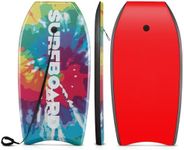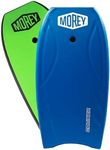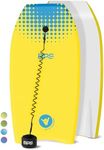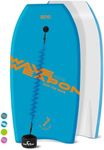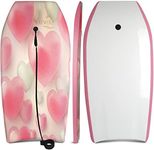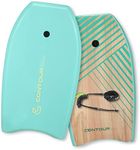Buying Guide for the Best Kids Body Boards
Choosing the right body board for kids can make a huge difference in their enjoyment and safety while playing in the water. It's important to consider several key specifications to ensure the board is suitable for their size, skill level, and the type of waves they'll be riding. Here's a guide to help you navigate through the essential specs and pick the best fit for your child.SizeThe size of the body board is crucial because it affects the child's ability to control the board and have fun. Body boards come in various lengths, typically ranging from 33 to 45 inches. For younger or smaller children, a shorter board (around 33-37 inches) is easier to handle and maneuver. Older or larger kids might need a longer board (38-45 inches) for better stability and buoyancy. To pick the right size, consider the child's height and weight; the board should be about the same length as the distance from their chin to their knees.
MaterialBody boards are made from different materials, each offering varying levels of durability and performance. The most common materials are EPS (Expanded Polystyrene), PE (Polyethylene), and PP (Polypropylene). EPS boards are lightweight and affordable, making them great for beginners. PE boards are more durable and offer better performance in various wave conditions, suitable for intermediate riders. PP boards are the most advanced, providing excellent strength and flexibility, ideal for more experienced kids. Choose the material based on your child's skill level and how often they will use the board.
ShapeThe shape of the body board affects how it rides on the waves. Boards with a wider nose and tail provide more stability and are easier for beginners to control. Narrower boards are faster and more maneuverable, suitable for kids who have some experience and want to perform tricks. Consider your child's experience and what they want to achieve with their body boarding when selecting the shape.
Tail TypeThe tail type of a body board influences its performance in the water. The most common tail shapes are crescent and bat tails. Crescent tails offer better control and stability, making them ideal for beginners and smaller waves. Bat tails provide more speed and maneuverability, suitable for more experienced riders and larger waves. Choose the tail type based on your child's skill level and the type of waves they will be riding.
CoreThe core of the body board is the inner material that provides buoyancy and flexibility. Common core materials include EPS, PE, and PP. EPS cores are lightweight and affordable, great for beginners. PE cores offer more durability and flexibility, suitable for intermediate riders. PP cores are the most advanced, providing excellent strength and performance, ideal for experienced kids. Select the core material based on your child's skill level and how often they will use the board.
DeckThe deck is the top surface of the body board where the rider lies. Decks are usually made from materials like IXPE (Crosslinked Polyethylene) or HDPE (High-Density Polyethylene). IXPE decks are soft and comfortable, providing a good grip for beginners. HDPE decks are more durable and offer better performance, suitable for intermediate and advanced riders. Choose the deck material based on your child's comfort and skill level.
StringerA stringer is a reinforcement rod inside the body board that adds strength and flexibility. Boards with stringers are more durable and provide better performance, especially in larger waves. For beginners, a board without a stringer is usually sufficient. For intermediate and advanced riders, a board with one or more stringers can enhance their experience. Consider your child's skill level and the type of waves they will be riding when deciding on the stringer.
